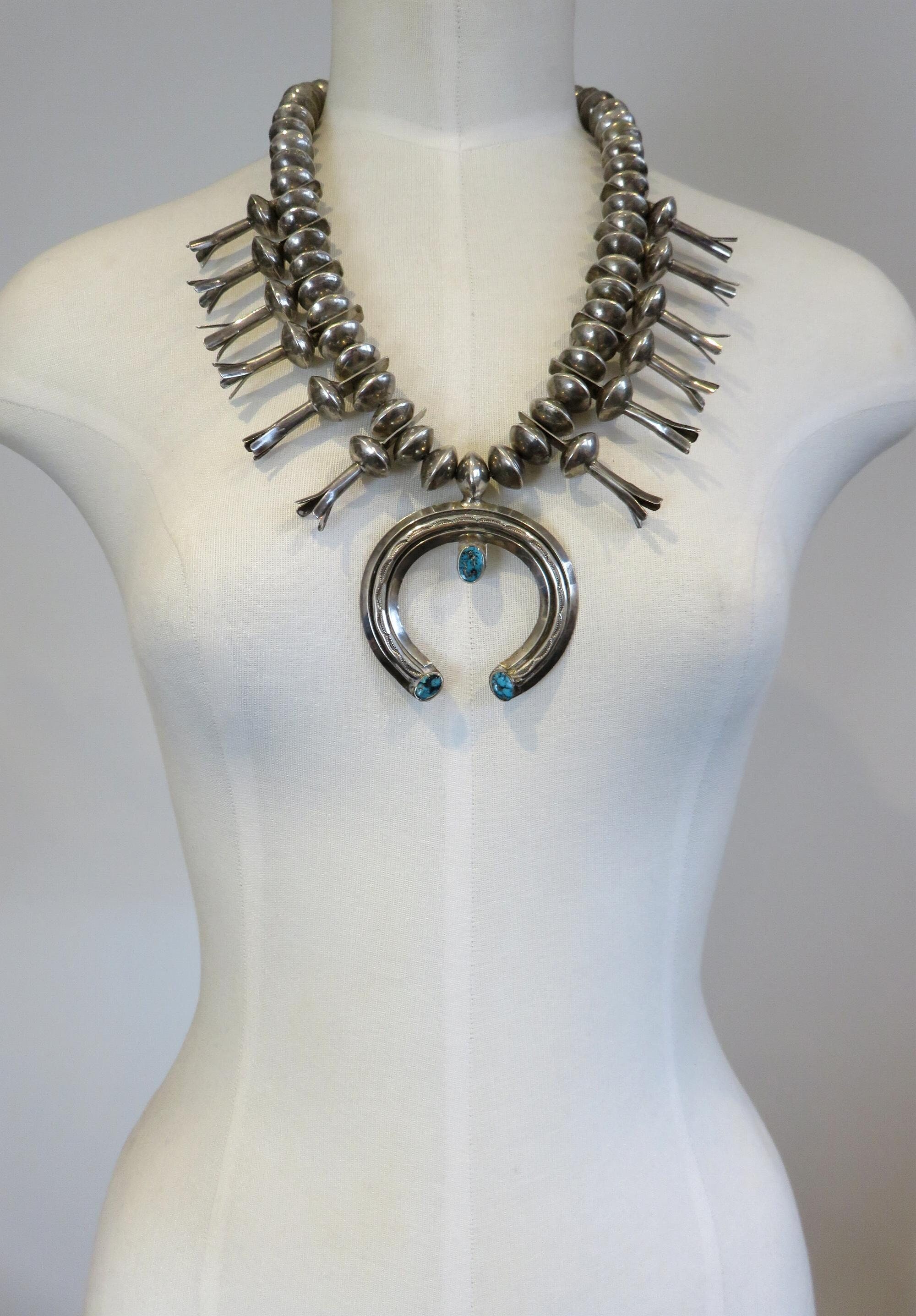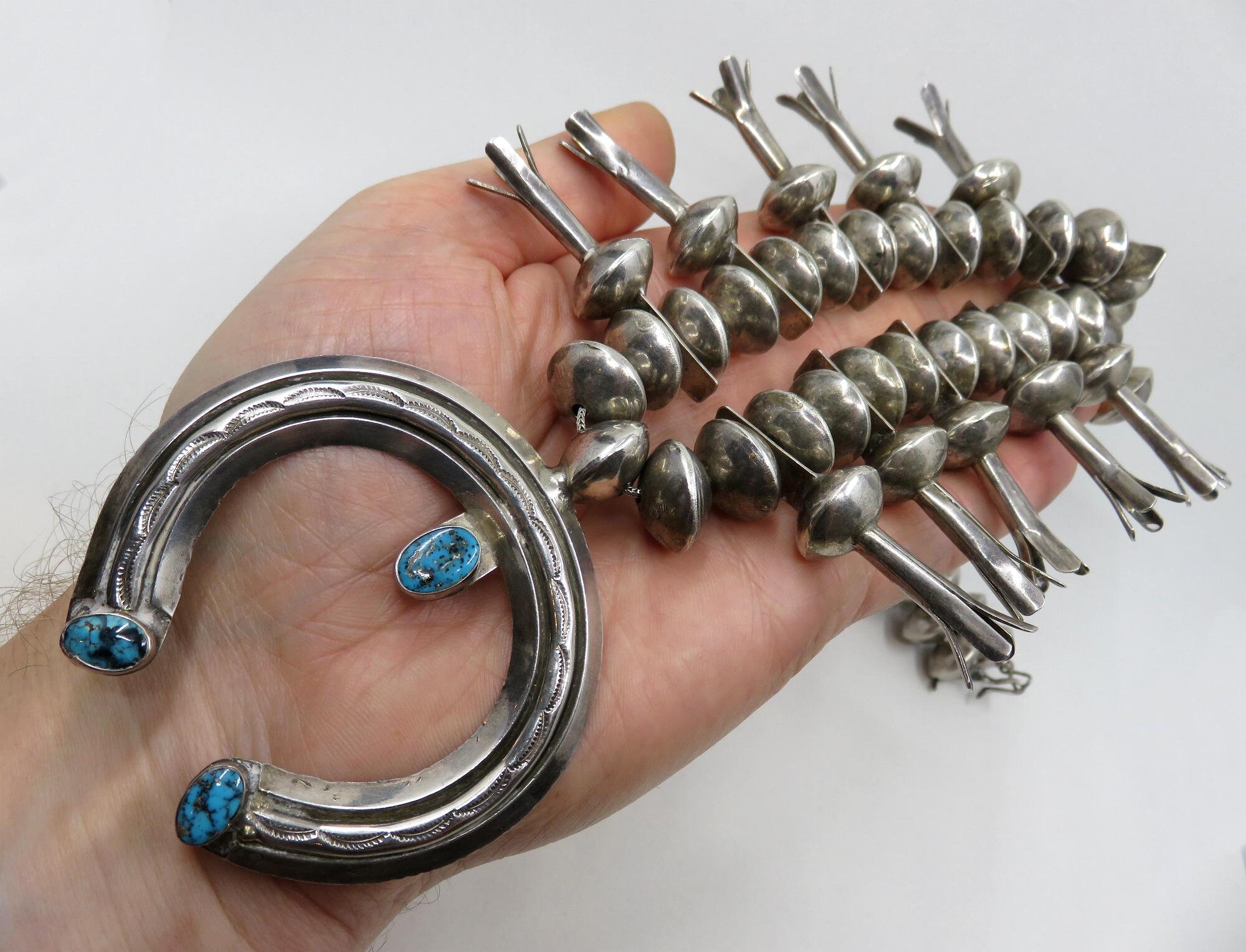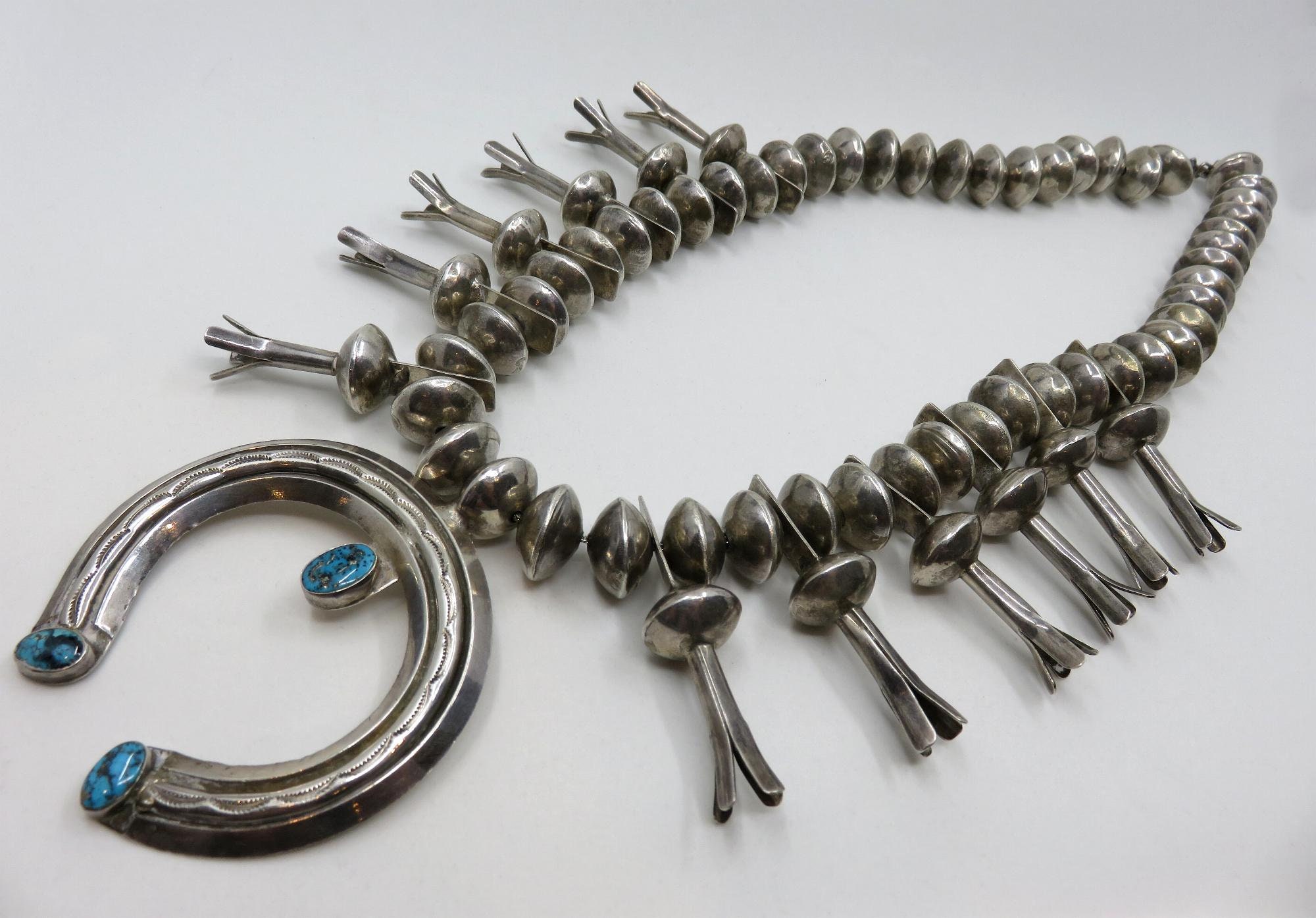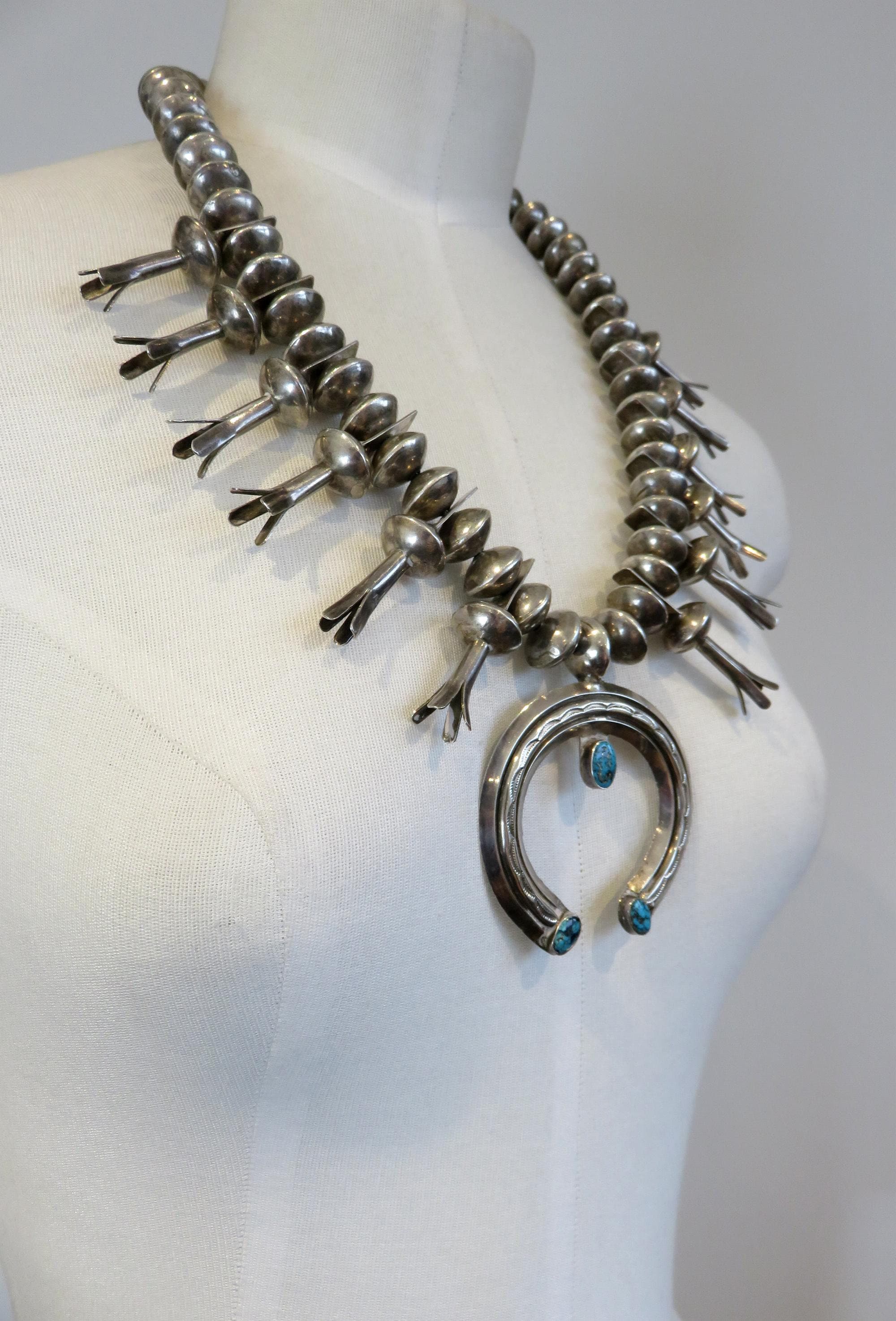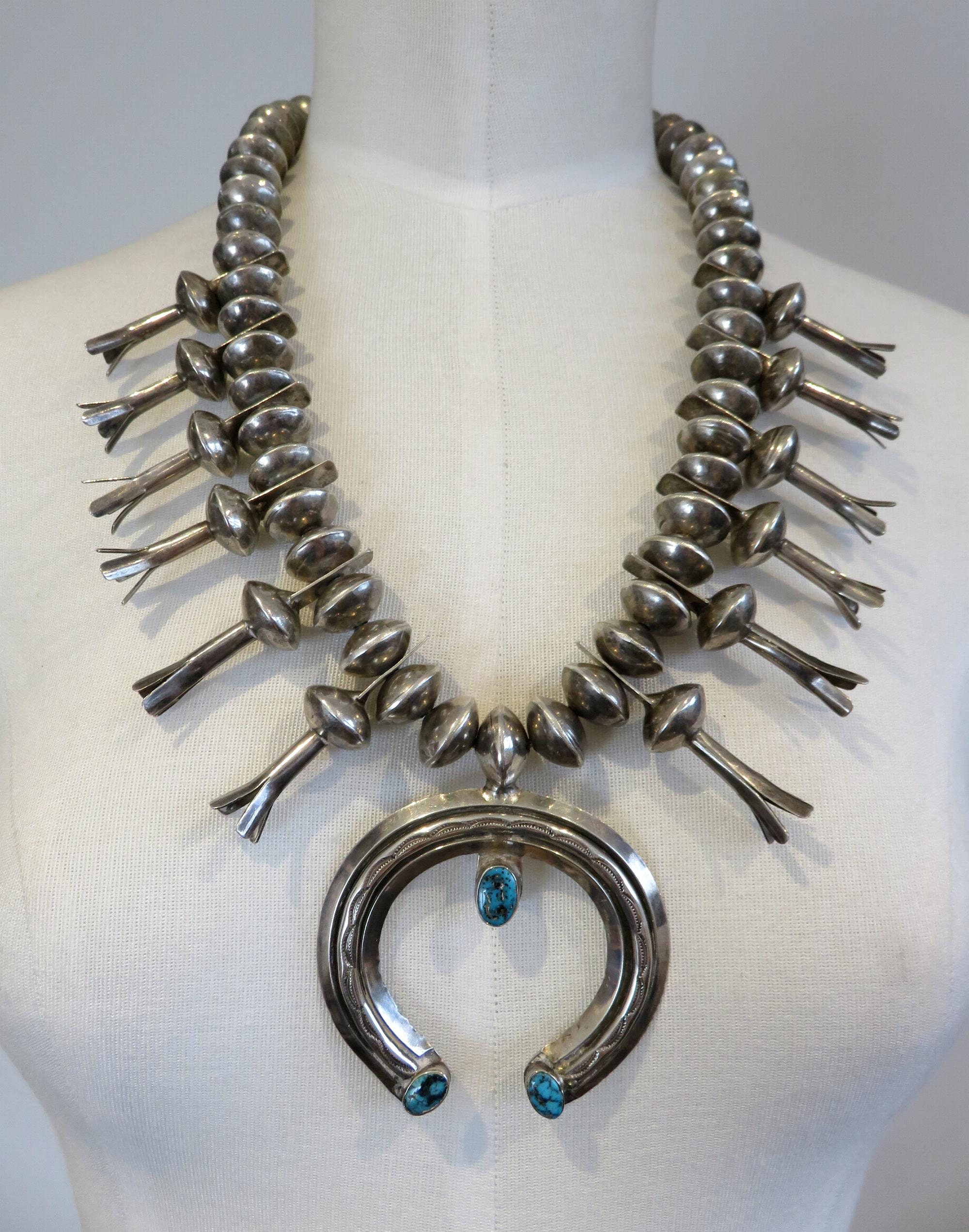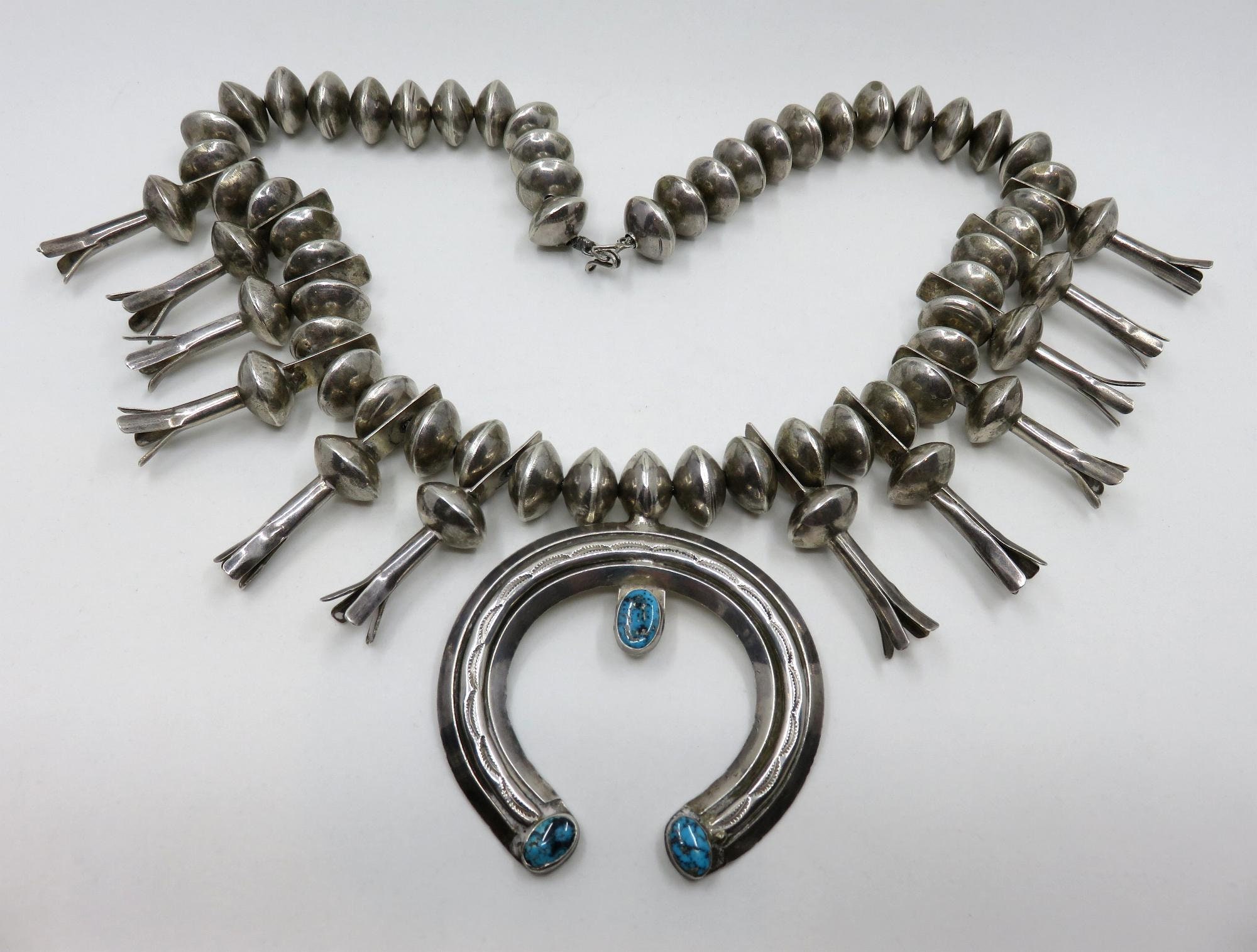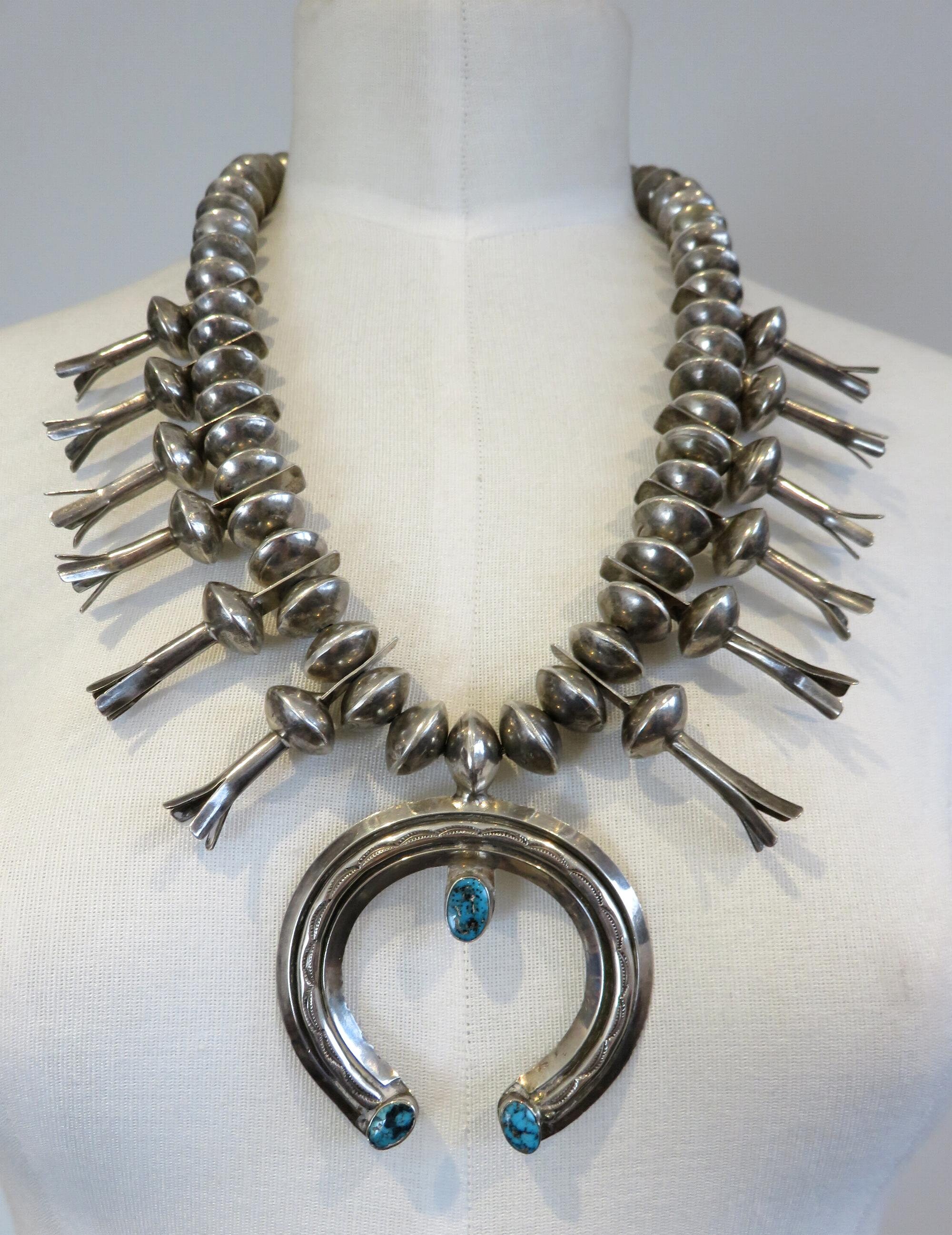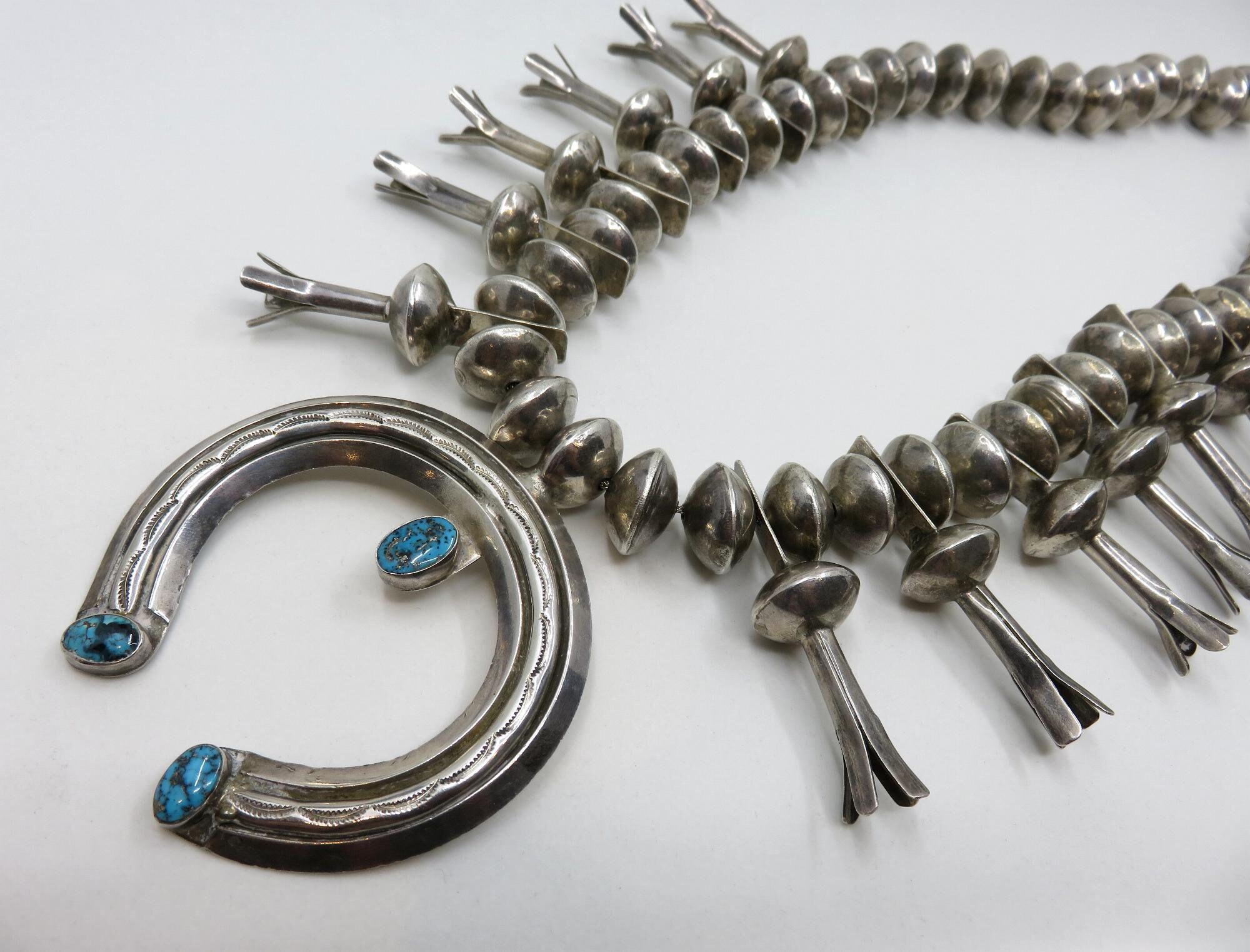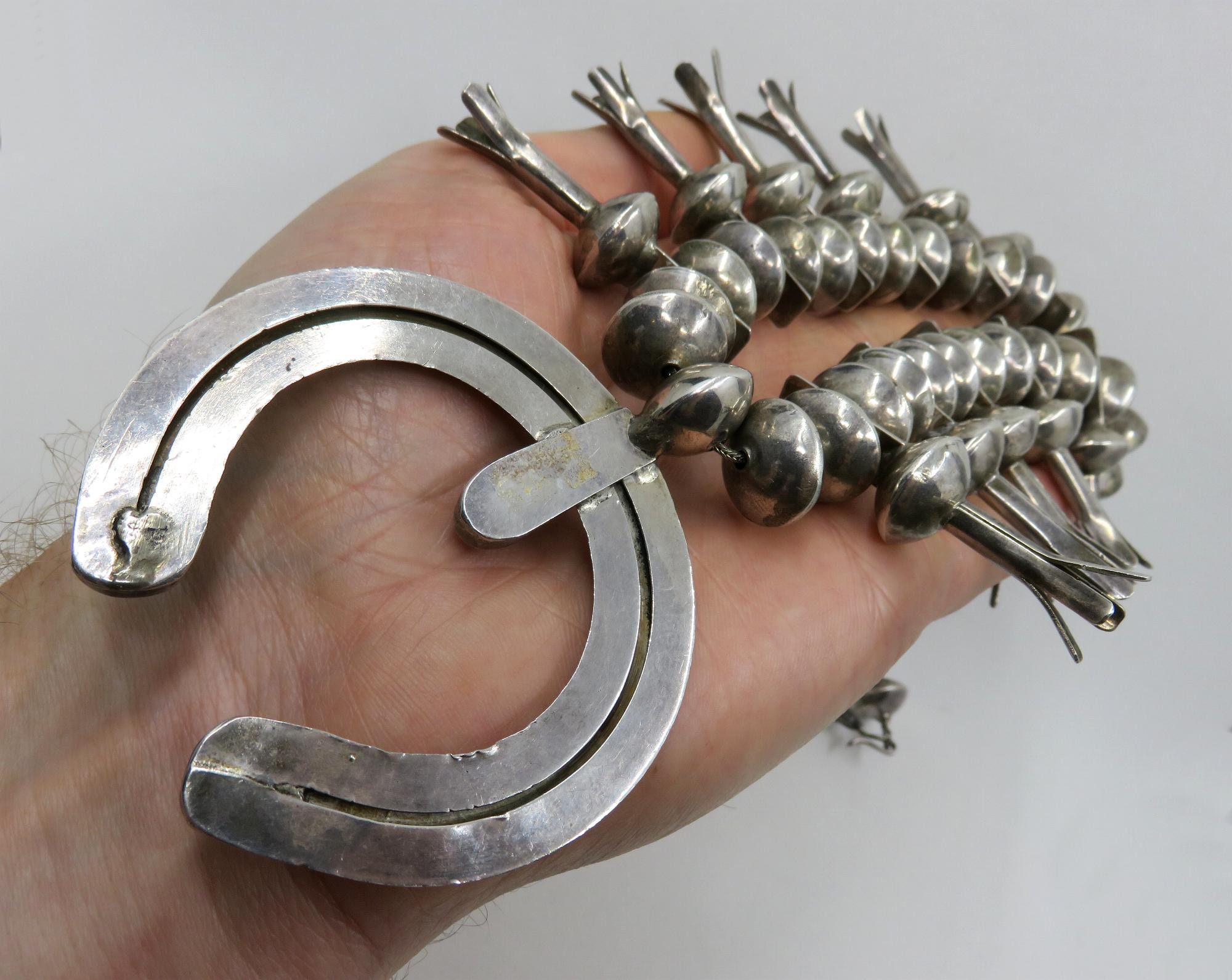Vintage Huge Sterling Silver Rare Historical Navajo Turquoise Squash Blossom Necklace 22" Length 243 grams
$9,875.46
Vintage, rare, historical, Navajo sterling silver squash blossom necklace, set with 3 subtle Arizona turquoise cabochons. In excellent vintage condition, lovely patina. History of the ownership of this incredible piece below.
Dimensions of Squash:
Naja Width 2.8"
Naja Height 2.7"
Length 22"
Weight 243 grams
Full length with Naja drop - 25"
Please check out my other designs and vintage pieces here:
https://www.etsy.com/uk/shop/YouGotTheSilverUK
Click on customise for any custom queries or bespoke pieces.
An original squash blossom necklace is formed with silver and turquoise and entails round silver beads intermingled with beads that appear like they are blooming, all which lead down to a horse-shoe like pendant at the bottom called the Naja.
The Navajo tribe was the first to adopt this design after encounters with the Spanish Mexicans that arrived at their land. The name ‘squash blossom’ originated by the signature beads found in the necklace, that spread out like a blossoming flower.
The Naja symbol was created as a talisman for protection, to ward off evil spirits. The Naja shape has also been known as an illustration of the womb, and when a squash blossom necklace has one turquoise piece suspended from the Naja, it is interpreted to be a representation of a child in the womb.
History of the piece: "The first Welsh Silent Movie Star"
William John Hughes was born on 23 August 1894 at Halfway, Dafen, Llanelli, Carmarthenshire, the elder son of John Elias Hughes, a tinplate boxer, and Ann Hughes (née Morgan). His father was an accomplished orator who won many prizes at local eisteddfodau. His younger brother was Brinley Hughes. The family subsequently moved to Princess Street, Llanelli. William John was educated at the Higher Elementary School, Llanelli. Although apprenticed to a chemist in Vaughan Street, he left home in 1911 to pursue an acting career in London, and it was at this time that he adopted the stage name Gareth Hughes.
He obtained work with the Alan Wilkie Shakespearean touring company and F. B. Wolfe's Repertoire Company performing melodrama in 1911. Further engagements in south Wales and then with Denis Hogan and Amanda Beresford's Shakespearean company in 1912 preceded his inclusion in a company of Welsh Players. The Players toured a farce, Little Miss Llewellyn, during the first half of 1913. As part of a Welsh National Theatre movement in January 1914 he sailed to America with the Welsh Players to perform J. O. Francis's prizewinning play Change. Gareth initially played the small part of Dai Matthews, a socialist agitator but, at the end of the tour in Chicago, took over the part of Gwilym Price, an invalid and one of the three sons in the play. Gareth's performance as Gwilym won him high praise and, as a result, he remained in America at the end of the engagement.
Starring roles in theatre productions on Broadway, in Chicago and Los Angeles followed over the next three years. Gareth accepted his first starring film role in Chicago in late 1915 and went to Hollywood to play a leading role with Clara Kimball Young in Eyes of Youth in 1919. In September 1920 he was contracted to Metro Films and billed as 'Metro's Boy Star'. However, before being able to commence work with Metro, author James Barrie selected Gareth to star as Tommy Sandys in the film of his book Sentimental Tommy and, loaned to Famous Players Lasky for this role, he returned to the East Coast to film at the new Paramount Astoria Studios on Long Island. On his return to Hollywood in 1921 he purchased land for a home in Laurel Canyon and began work on the first of five films for Metro, directed by George Baker. He became a US citizen in 1922 and worked almost exclusively in film until 1925. He returned home in October 1922 while filming Enemies of Women in Europe and again in the autumn of 1924. In July 1924 and February 1925 he appeared in Vaudeville and appeared in theatre once more in New York in The Dunce Boy in April and May 1925.
From 1925 until 1931 he continued to appear in films and the occasional theatre production. His career, however, was waning at this time. Gareth's accent wasn't a problem as movies transitioned from silent to talkies; his success on the stage was proof of this. It was more his physicality which hindered progress. He was only 5' 7” tall and had the body of a pin. His youthful and ethereal manner belied his advancing years and he simply lacked the 'ruggedness' required of the leading men of the day. He was, quite clearly, not being offered the kind of role which would help him to survive into the next decade of film making. In 1929 his investments were wiped out in the Wall Street Stock Market crash and for a number of years in the 1930s he found himself without funds and without work, moving from apartment to apartment in the Echo Park district of Los Angeles.
In January 1936 he joined the Federal Theatre Project in Los Angeles, an initiative started by President Roosevelt's Works Project Administration to support ailing professions. Gareth's first involvement with the project was as an actor working 96 hours per month for $94.08 a month. In the spring of 1937 he played Shylock in The Merchant of Venice at the Hollywood Playhouse, a role he had played to great acclaim as a schoolboy in Llanelli. In November 1937 he was reassigned as Director of Religious and Shakespearean Drama for the project at $175.76 for a 169 hour month. He adapted shorter versions of Shakespeare and Early English Miracle Plays for performances in theatres, schools, churches and institutions in Los Angeles. Ill health and exhaustion forced his retirement from the project in March 1939.
In 1941, experiencing an immense desire to serve God, Gareth was baptized at St Athanasius Church, Los Angeles and confirmed by Bishop Stevens. He was determined to take Holy Orders and was admitted as a postulant to the Society of St. John the Evangelist at Cambridge, Massachusetts, taking the title Brother David. However, deemed as unsuitable for Holy Orders he left the Society, and made a second attempt at the Order of the Holy Cross in New York in 1943. In 1944 he worked as dialect coach to Bette Davis and the cast of the Emlyn Williams play The Corn Is Green, before accepting an offer to serve as a Lay Minister for the Order of the Holy Cross on the Pyramid Lake Indian Reservation at Nixon, Nevada.
Brother David served at Nixon, at nearby Wadsworth and at Fort McDermitt on the Nevada Oregon border until 1956. The methods he employed in his service were seen as controversial by many of his colleagues and his ability to cater to the needs of the Paiute people, whom he called 'his children', was regularly challenged. It was a difficult path, but his ability to reach the Paiutes in a way no other white man had to date was recognised by Bishop Lewis, Head of the Protestant Diocese of Nevada. He was greatly loved by the Paiutes he cared for. There was a massive increase in Church attendance at Nixon and Wadsworth while Brother David was in charge. He encouraged businesses and events to engage in activities which benefited the tribe; speedboat races on Pyramid Lake provided rental revenue for example. He persuaded his old Hollywood friends to supply films to show in the Church Hall and to donate clothing. He taught the Paiutes to polish stones to make jewellery to sell, providing the mountings and fixings himself, and instituted a sewing club. He paid for shoes for the children from his own meagre salary. He persuaded hotel owners in Reno to host groups of young Paiutes for lunch while they obtained a glimpse of city life. He would do anything in his power to enhance their lives and he ensured that Paiutes who lost their lives serving the United States in Korea were honoured.
During his period as a Lay Minister he also accepted a position at the English Department of the University of Reno in the late 1940s where he would coach the students in Shakespeare and direct them in performance. He was a regular member and speaker for many local societies and helped to organise pageants and festivals. In 1956 he took up a post at a Reno wedding chapel where he married Paiutes and celebrities alike, and used his salary to benefit the people of the reservation.
Ill health once again forced his retirement and he returned to Wales in 1958. However, his stay lasted less than eight months. Having lived for many years in the rigours of the Nevada desert he had difficulty in accepting the Welsh climate. He returned to the US to live at the Motion Picture Country House and Hospital at Woodland Hills, California. Having paid his dues while a film actor he was entitled to a place at this film industry retirement home. Brother David became the unofficial chaplin and baptized both Clara Kimball Young and Edmund Gwenn there before their deaths. In 1963 he flew to London to appear as the surprise guest on a This Is Your Life tribute to Bessie Love, with whom he had starred in Forget Me Not in 1922.
Suffering from byssinosis, fibre on the lung caused by years of sorting the gifts of second hand clothing donated to his beloved Paiutes, he died at the home on 1 October 1965, aged 71. He was cremated at the Chapel of the Pines, Reno, on 4 October and buried at the Masonic Cemetery, Reno.
His legacy as an actor is undeniable; the extent of his career and the plaudits he earned are sufficient testimony. At one stage of his career he was billed as 'America's Foremost Young Actor'. His legacy as a missionary and humanitarian, his greatest legacy, was carried in the hearts of the children he taught and for whom he cared for over fifty years after he left the reservation. Sadly, as they have passed on, this legacy is all but forgotten.
Shipping from United Kingdom
Processing time
1-3 business days
Customs and import taxes
Buyers are responsible for any customs and import taxes that may apply. I'm not responsible for delays due to customs.
Payment Options
Returns & Exchanges
I gladly accept returns and exchanges
Just contact me within: 7 days of delivery
Ship items back to me within: 14 days of delivery
I don't accept cancellations
But please contact me if you have any problems with your order.
The following items can't be returned or exchanged
Because of the nature of these items, unless they arrive damaged or defective, I can't accept returns for:
- Custom or personalized orders
- Perishable products (like food or flowers)
- Digital downloads
- Intimate items (for health/hygiene reasons)
- Items on sale
Conditions of return
Buyers are responsible for return shipping costs. If the item is not returned in its original condition, the buyer is responsible for any loss in value.
Frequently Asked Questions
Custom and personalised orders
I accept custom requests and personalised options where available.
Bespoke customs designs are agreed before payment. Custom items are non refundable.
Sizing details
I make all my handmade rings, bracelets and pendants to the size requested at checkout. For vintage items, especially bracelets and bangle cuffs please check all measurements in the listing description. Checking sizes against your own jewellery is a good way also to confirm the fit. Please get in contact if you need any help with sizing.
Care instructions
I have a blog on my website (below) on how to care for jewellery. I also supply a free polishing cloth for most orders.
https://yougotthesilveruk.patternbyetsy.com/post/159974548155/a-few-tips-and-info-on-how-to-clean
Gift wrapping and packaging
All items come boxed with a YGTS logo ready to gift. Headed paperwork supplied with no cost of purchase info on the invoice.
Wholesale availability
I currently don't offer wholesale quantity as my handmade items are carefully priced. But I will consider requests.
Express Shipping
I offer free worldwide shipping. If an Express service is required, usually 3-5 days, I can create an invoice to cover this (at cost) with your purchase. Please contact me before purchase to arrange it.
Shipping Information
I process and ship vintage and already manufactured items in 1-3 working days. Handmade items, made to a specific size are shipped within 5 to 7 working days. (Weekends excluded)
International postage usually takes 5-7 days to arrive in your country from dispatch, then it's down to customs processing in the buyers country. I supply tracking numbers and timescale info via email for all orders.

